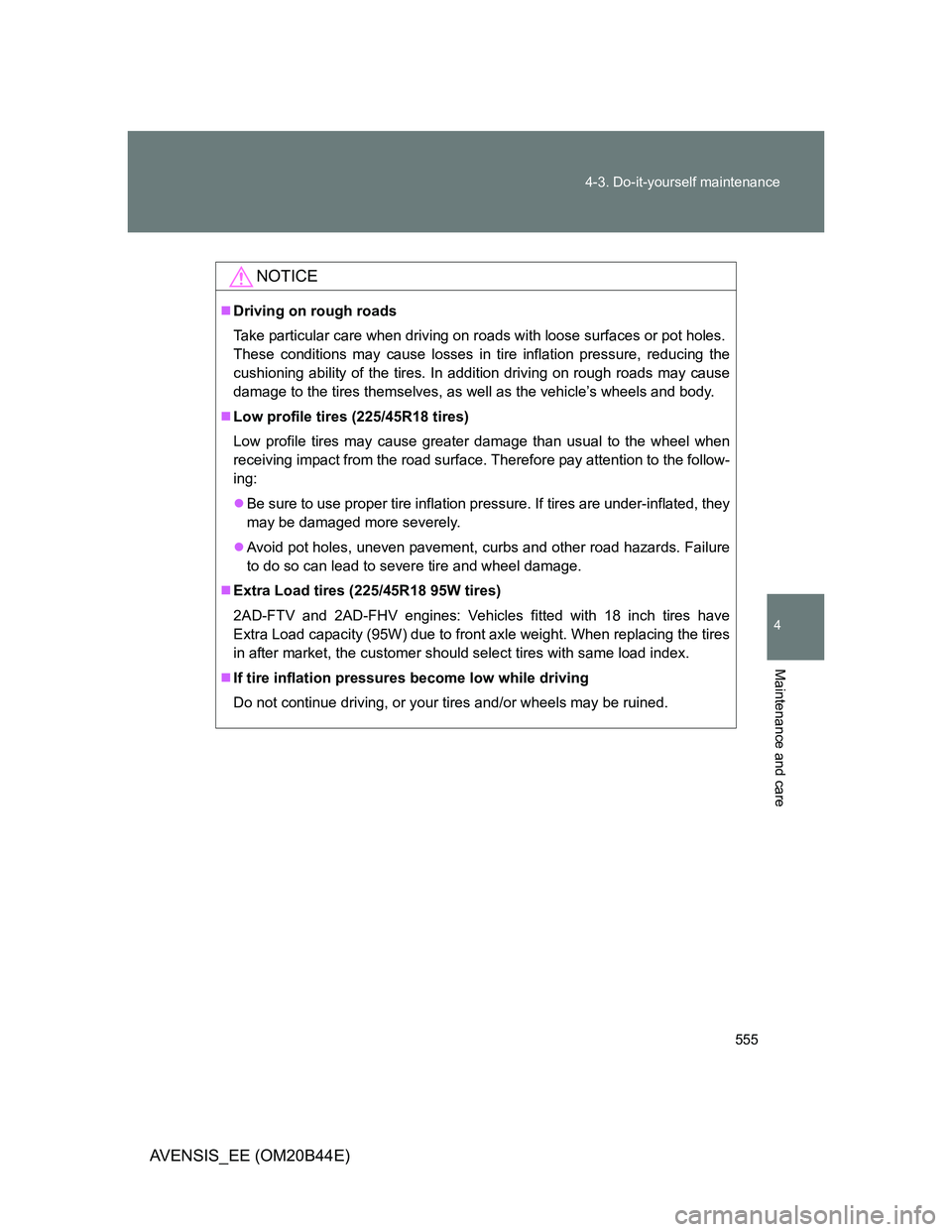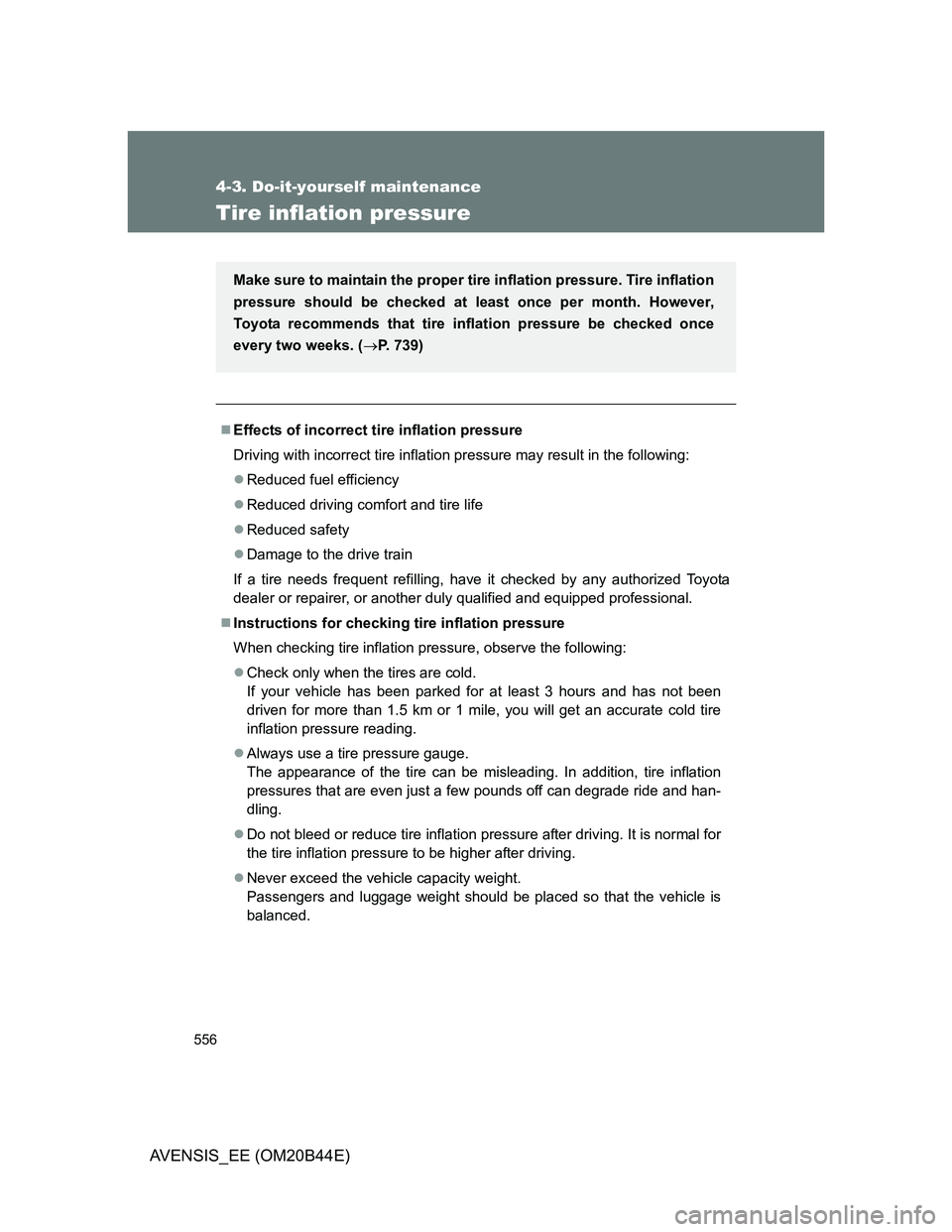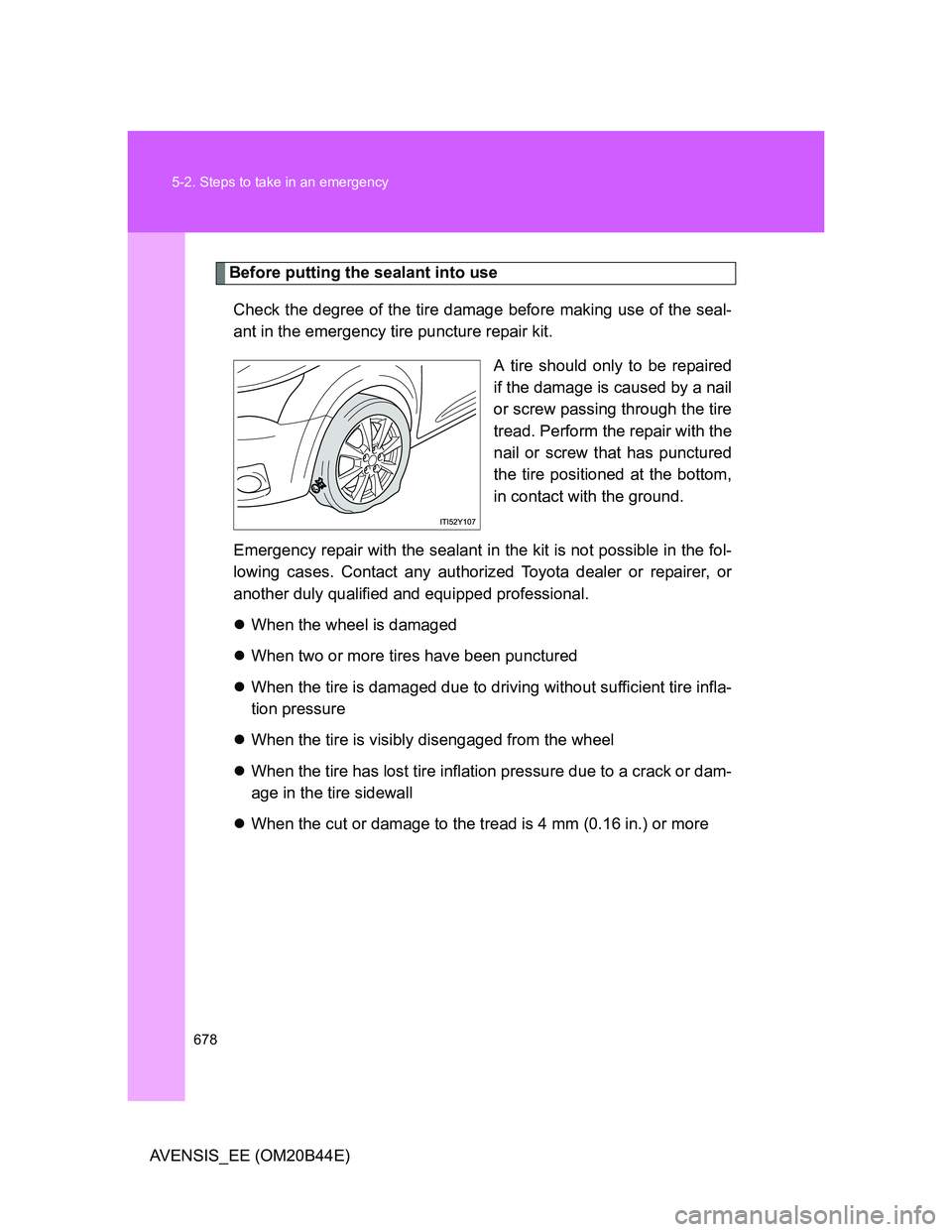Page 528 of 772
528 4-3. Do-it-yourself maintenance
AVENSIS_EE (OM20B44E)
ItemsParts and tools
Fuses (P. 569)• Fuse with same amperage rating
as original
Radiator, condenser and inter-
cooler (P. 545)
Tire inflation pressure (P. 556)• Tire pressure gauge
• Compressed air source
Washer fluid (P. 549)
• Water or washer fluid containing
antifreeze (for winter use)
• Funnel
Page 552 of 772
552
4-3. Do-it-yourself maintenance
AVENSIS_EE (OM20B44E)
Tires
Replace the tires when the treadwear indicators show.
Checking tires
New tread
Treadwear indicator
Worn tread
The location of treadwear indi-
cators is shown by the “TWI” or
“ ” marks, etc., molded on
the sidewall of each tire.
Check spare tire condition and
inflation pressure if not rotated.
Tire rotation
Vehicles with a spare tire of different wheel type from the
installed tires or an emergency puncture repair kit
Rotate the tires in the order
shown.
To equalize tire wear and help
extend tire life, Toyota recom-
mends that you rotate your
tires approximately every
10000 km (6000 miles).
Front
Page 555 of 772

555 4-3. Do-it-yourself maintenance
4
Maintenance and care
AVENSIS_EE (OM20B44E)
NOTICE
Driving on rough roads
Take particular care when driving on roads with loose surfaces or pot holes.
These conditions may cause losses in tire inflation pressure, reducing the
cushioning ability of the tires. In addition driving on rough roads may cause
damage to the tires themselves, as well as the vehicle’s wheels and body.
Low profile tires (225/45R18 tires)
Low profile tires may cause greater damage than usual to the wheel when
receiving impact from the road surface. Therefore pay attention to the follow-
ing:
Be sure to use proper tire inflation pressure. If tires are under-inflated, they
may be damaged more severely.
Avoid pot holes, uneven pavement, curbs and other road hazards. Failure
to do so can lead to severe tire and wheel damage.
Extra Load tires (225/45R18 95W tires)
2AD-FTV and 2AD-FHV engines: Vehicles fitted with 18 inch tires have
Extra Load capacity (95W) due to front axle weight. When replacing the tires
in after market, the customer should select tires with same load index.
If tire inflation pressures become low while driving
Do not continue driving, or your tires and/or wheels may be ruined.
Page 556 of 772

556
4-3. Do-it-yourself maintenance
AVENSIS_EE (OM20B44E)
Tire inflation pressure
Effects of incorrect tire inflation pressure
Driving with incorrect tire inflation pressure may result in the following:
Reduced fuel efficiency
Reduced driving comfort and tire life
Reduced safety
Damage to the drive train
If a tire needs frequent refilling, have it checked by any authorized Toyota
dealer or repairer, or another duly qualified and equipped professional.
Instructions for checking tire inflation pressure
When checking tire inflation pressure, observe the following:
Check only when the tires are cold.
If your vehicle has been parked for at least 3 hours and has not been
driven for more than 1.5 km or 1 mile, you will get an accurate cold tire
inflation pressure reading.
Always use a tire pressure gauge.
The appearance of the tire can be misleading. In addition, tire inflation
pressures that are even just a few pounds off can degrade ride and han-
dling.
Do not bleed or reduce tire inflation pressure after driving. It is normal for
the tire inflation pressure to be higher after driving.
Never exceed the vehicle capacity weight.
Passengers and luggage weight should be placed so that the vehicle is
balanced.
Make sure to maintain the proper tire inflation pressure. Tire inflation
pressure should be checked at least once per month. However,
Toyota recommends that tire inflation pressure be checked once
every two weeks. (P. 739)
Page 557 of 772
557 4-3. Do-it-yourself maintenance
4
Maintenance and care
AVENSIS_EE (OM20B44E)
CAUTION
Proper inflation is critical to save tire performance
Keep your tires properly inflated. Otherwise, the following conditions may
occur and result in an accident causing death or serious injury.
Excessive wear
Uneven wear
Poor handling
Possibility of blowouts resulting from overheated tires
Poor sealing of the tire bead
Wheel deformation and/or tire separation
A greater possibility of tire damage from road hazards
NOTICE
When inspecting and adjusting tire inflation pressure
Be sure to reinstall the tire valve caps.
Without the valve caps, dirt or moisture could get into the valve and cause
air leakage, which could result in an accident. If the caps have been lost,
replace them as soon as possible.
Page 656 of 772
656 5-2. Steps to take in an emergency
AVENSIS_EE (OM20B44E)Vehicles with a steel wheel, rein-
stall the wheel ornament.
Align the cutout of the wheel
ornament with the valve stem as
shown.
Stow the flat tire, tire jack and all tools.
STEP5
The compact spare tire
The compact spare tire is identified by the label “TEMPORARY USE
ONLY” on the tire sidewall.
Use the compact spare tire temporarily only in an emergency.
Make sure to check the tire inflation pressure of the compact spare tire.
(P. 739)
If you have a flat front tire on a road covered with snow or ice
Install the compact spare tire on the rear of the vehicle. Perform the following
steps and fit tire chains to the front tires.
Replace a rear tire with the compact spare tire.
Replace the flat front tire with the tire removed from the rear of the
vehicle.
Fit tire chains to the front tires.
STEP6
STEP1
STEP2
STEP3
Page 670 of 772
670 5-2. Steps to take in an emergency
AVENSIS_EE (OM20B44E)Vehicles with a steel wheel, rein-
stall the wheel ornament.
Align the cutout of the wheel
ornament with the valve stem as
shown.
Stow the flat tire, tire jack and all tools.
STEP5
The compact spare tire
The compact spare tire is identified by the label “TEMPORARY USE
ONLY” on the tire sidewall.
Use the compact spare tire temporarily only in an emergency.
Make sure to check the tire inflation pressure of the compact spare tire.
(P. 739)
If you have a flat front tire on a road covered with snow or ice
Install the compact spare tire on the rear of the vehicle. Perform the following
steps and fit tire chains to the front tires.
Replace a rear tire with the compact spare tire.
Replace the flat front tire with the tire removed from the rear of the
vehicle.
Fit tire chains to the front tires.
STEP6
STEP1
STEP2
STEP3
Page 678 of 772

678 5-2. Steps to take in an emergency
AVENSIS_EE (OM20B44E)
Before putting the sealant into use
Check the degree of the tire damage before making use of the seal-
ant in the emergency tire puncture repair kit.
A tire should only to be repaired
if the damage is caused by a nail
or screw passing through the tire
tread. Perform the repair with the
nail or screw that has punctured
the tire positioned at the bottom,
in contact with the ground.
Emergency repair with the sealant in the kit is not possible in the fol-
lowing cases. Contact any authorized Toyota dealer or repairer, or
another duly qualified and equipped professional.
When the wheel is damaged
When two or more tires have been punctured
When the tire is damaged due to driving without sufficient tire infla-
tion pressure
When the tire is visibly disengaged from the wheel
When the tire has lost tire inflation pressure due to a crack or dam-
age in the tire sidewall
When the cut or damage to the tread is 4 mm (0.16 in.) or more